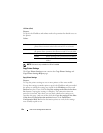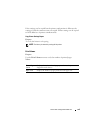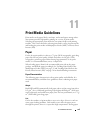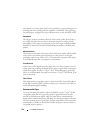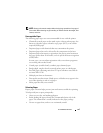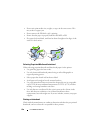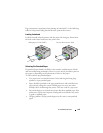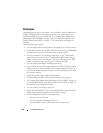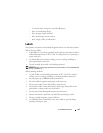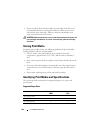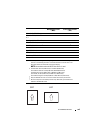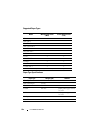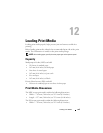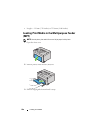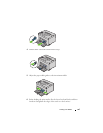
160 Print Media Guidelines
Envelopes
Depending on the choice of envelopes, it is possible to expect variable levels
of light wrinkling. Before buying large quantities of any print media, it is
recommended that you try a sample first. See "Loading Print Media in the
Multipurpose Feeder (MPF)" on page166 or "Loading Print Media in the
Priority Sheet Inserter (PSI)" on page173 for instructions on loading an
envelope.
When printing on envelopes:
• Use only high-quality envelopes that are designed for use in laser printers.
• Set the print media source to MPF or PSI. Set the paper type to
Envelope
,
and select the correct size of envelope from the printer driver.
• For best performance, use envelopes made from 75 g/m
2
(20 lb bond)
paper. You can use up to 105 g/m
2
(28 lb bond) weight for the envelope
feeder as long as the cotton content is 25% or less. Envelopes with 100%
cotton content must not exceed 90 g/m
2
(24 lb bond) weight.
• Use only freshly unpackaged, undamaged envelopes.
• Use envelopes that can withstand temperatures of 205°C (401°F) without
sealing, excessive curling, wrinkling, or releasing hazardous emissions. If
you have any doubts about the envelopes you are considering, check with
the envelope supplier.
• Adjust the guide to fit the width of the envelopes.
• To load envelope in MPF or PSI, the print side must be facing up.
• See "Loading Print Media in the Multipurpose Feeder (MPF)" on page45
or "Loading Print Media in the Priority Sheet Inserter (PSI)" on page50
for instructions on loading an envelope.
• Use one envelope size during a print job.
• Ensure that the humidity is low because high humidity (more than 60%)
and the high printing temperatures may seal the envelopes.
• For best performance, do not use envelopes that:
– Have excessive curl or twist
– Are stuck together or damaged in any way
– Contain windows, holes, perforations, cutouts, embossing



